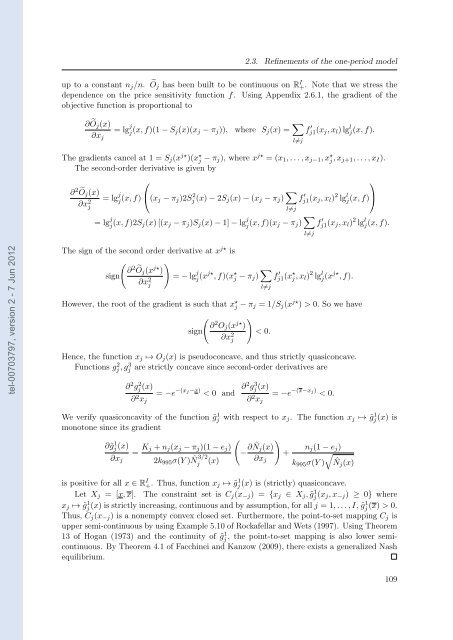Etude des marchés d'assurance non-vie à l'aide d'équilibres de ...
Etude des marchés d'assurance non-vie à l'aide d'équilibres de ...
Etude des marchés d'assurance non-vie à l'aide d'équilibres de ...
Create successful ePaper yourself
Turn your PDF publications into a flip-book with our unique Google optimized e-Paper software.
tel-00703797, version 2 - 7 Jun 2012<br />
2.3. Refinements of the one-period mo<strong>de</strong>l<br />
up to a constant nj/n. Oj has been built to be continuous on R I +. Note that we stress the<br />
<strong>de</strong>pen<strong>de</strong>nce on the price sensitivity function f. Using Appendix 2.6.1, the gradient of the<br />
objective function is proportional to<br />
∂ Oj(x)<br />
= lg<br />
∂xj<br />
j<br />
j (x, f)(1 − Sj(x)(xj − πj)), where Sj(x) = <br />
f ′ j1(xj, xl) lg l j(x, f).<br />
The gradients cancel at 1 = Sj(x j⋆ )(x ⋆ j − πj), where x j⋆ = (x1, . . . , xj−1, x ⋆ j , xj+1, . . . , xI).<br />
The second-or<strong>de</strong>r <strong>de</strong>rivative is given by<br />
∂ 2 Oj(x)<br />
∂x 2 j<br />
= lg j<br />
j<br />
⎛<br />
(x, f) ⎝(xj − πj)2S 2 j (x) − 2Sj(x) − (xj − πj) <br />
= lg j<br />
j (x, f)2Sj(x) [(xj − πj)Sj(x) − 1] − lg j<br />
The sign of the second or<strong>de</strong>r <strong>de</strong>rivative at xj⋆ is<br />
<br />
∂<br />
sign<br />
2Oj(x j⋆ )<br />
∂x2 <br />
= − lg<br />
j<br />
j<br />
l=j<br />
l=j<br />
j (x, f)(xj − πj) <br />
f ′ j1(xj, xl) 2 lg l j(x, f)<br />
l=j<br />
⎞<br />
⎠<br />
f ′ j1(xj, xl) 2 lg l j(x, f).<br />
j (xj⋆ , f)(x ⋆ j − πj) <br />
f<br />
l=j<br />
′ j1(x ⋆ j, xl) 2 lg l j(x j⋆ , f).<br />
However, the root of the gradient is such that x ⋆ j − πj = 1/Sj(x j⋆ ) > 0. So we have<br />
sign<br />
<br />
∂2Oj(x j⋆ )<br />
∂x2 <br />
< 0.<br />
j<br />
Hence, the function xj ↦→ Oj(x) is pseudoconcave, and thus strictly quasiconcave.<br />
Functions g2 j , g3 j are strictly concave since second-or<strong>de</strong>r <strong>de</strong>rivatives are<br />
∂ 2 g 2 j (x)<br />
∂ 2 xj<br />
= −e −(xj−x) < 0 and ∂ 2 g 3 j (x)<br />
∂ 2 xj<br />
= −e −(x−xj) < 0.<br />
We verify quasiconcavity of the function ˜g 1 j with respect to xj. The function xj ↦→ ˜g 1 j (x) is<br />
monotone since its gradient<br />
∂˜g 1 j (x)<br />
∂xj<br />
= Kj + nj(xj − πj)(1 − ej)<br />
2k995σ(Y ) ˆ N 3/2<br />
j (x)<br />
<br />
− ∂ ˆ Nj(x)<br />
∂xj<br />
<br />
nj(1 − ej)<br />
+ <br />
k995σ(Y ) ˆNj(x)<br />
is positive for all x ∈ RI +. Thus, function xj ↦→ ˜g 1 j (x) is (strictly) quasiconcave.<br />
Let Xj = [x, x]. The constraint set is Cj(x−j) = {xj ∈ Xj, ˜g 1 j (xj, x−j) ≥ 0} where<br />
(x) > 0.<br />
xj ↦→ ˜g 1 j (x) is strictly increasing, continuous and by assumption, for all j = 1, . . . , I, ˜g1 j<br />
Thus, Cj(x−j) is a <strong>non</strong>empty convex closed set. Furthermore, the point-to-set mapping Cj is<br />
upper semi-continuous by using Example 5.10 of Rockafellar and Wets (1997). Using Theorem<br />
13 of Hogan (1973) and the continuity of ˜g 1 j , the point-to-set mapping is also lower semicontinuous.<br />
By Theorem 4.1 of Facchinei and Kanzow (2009), there exists a generalized Nash<br />
equilibrium.<br />
109
















